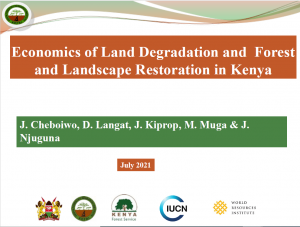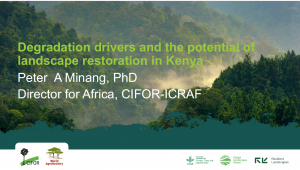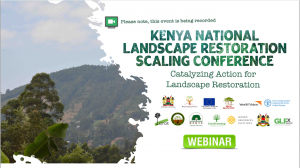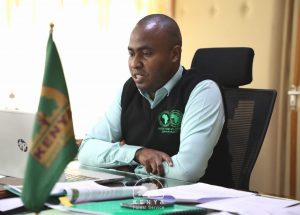Opening Session
Mieke Bourne Ochieng, Regreening Africa Programme Manager CIFOR-ICRAF
- To catalyze a national restoration movement towards the achievement of Kenya’s restoration ambitions
- Showcase different restoration practices and investigate their suitability for the different places and people.
- Provide a platform for engaging with policy makers that will contribute to necessary policy adjustments needed to support landscape restoration.
- Highlight the role of women and youth in restoration and outline potential for their greater inclusion.
- Identify bottlenecks and opportunities for greater restoration entrepreneurship and business.
- Agree on a process for a common monitoring, reporting, and learning framework for landscape restoration.
- Bring together stakeholders working in the restoration space to develop a common roadmap and agree on key actions.
- Catalyze funding for land restoration in the country towards realizing the vision of the UN Decade for Ecosystem Restoration. READ MORE
Economics of land degradation and forest and landscape restoration in Kenya
J. Cheboiwo, D. Langat, J. Kiprop, M. Muga & J.Njuguna, Kenya Forestry Research Institute (KEFRI)
 Forest and land degradation are a serious global problem, particularly in developing countries where most of the poor reside. About 30% of Kenya’s land mass is facing severe land degradation and this anticipated to become more acute with rising population. Restoration requires massive financial resources e.g. for the most conservative restoration scenario, it requires about KES 1.8 Trillion for the 5.1 million hectares. READ MORE
Forest and land degradation are a serious global problem, particularly in developing countries where most of the poor reside. About 30% of Kenya’s land mass is facing severe land degradation and this anticipated to become more acute with rising population. Restoration requires massive financial resources e.g. for the most conservative restoration scenario, it requires about KES 1.8 Trillion for the 5.1 million hectares. READ MORE
Kenya landscape restoration commitments and ambitions
Julius Kamau, Chief Conservator of Forests, Kenya Forest Service
- The Ministry of Environment and Forestry and Kenya Forest Service strive to protect and restore the degraded public forests, the biggest task lies within the degraded landscapes outside the gazetted public forests.
- Implementing the FLR initiatives on the ground means to maintain and restore areas that provide key ecosystem services, such as protecting catchments and enhancing biodiversity for sustainable agroforestry systems.
- Landscape Restoration Governance is therefore crucial to leverage and sustain lasting FLR initiatives.
- Sustained negotiations, trade-offs and power-balance between stakeholders is necessary for an enabling environment for partnerships, cooperation, collaboration and novel solutions.
- Such negotiations are critical in identifying and mapping where, how, for whom and by whom to restore the landscape and what outcomes are desired.
- FLR need to be designed in a way that attract private sector investment such out-growers scheme.
- In addition, it is fundamental to, ensure effective participation and empowerment of communities through the FLR initiative. READ MORE
Degradation drivers and the potential of landscape restoration in Kenya
Peter A. Minang, PhD, Director for Africa, CIFOR-ICRAF
 The main drivers of land degradation include agricultural activities, infrastructure extension, wood extraction and related activities, increased aridity, climatic factors, technological factors, economic factors, demographic factors, policy and institutional factors and cultural factors. However, these can be reversed when restoration is anchored on green value chains, domestic public investment and incentives, leveraging local knowledge and capacity, building on devolution, ensuring equitable and effective benefits flows to local people and adaptive responses to loss of ecosystem services. READ MORE
The main drivers of land degradation include agricultural activities, infrastructure extension, wood extraction and related activities, increased aridity, climatic factors, technological factors, economic factors, demographic factors, policy and institutional factors and cultural factors. However, these can be reversed when restoration is anchored on green value chains, domestic public investment and incentives, leveraging local knowledge and capacity, building on devolution, ensuring equitable and effective benefits flows to local people and adaptive responses to loss of ecosystem services. READ MORE
Watch the conference launch webinar here


